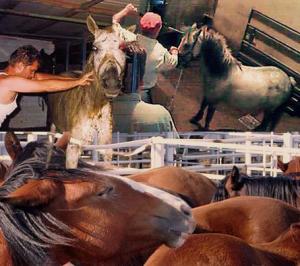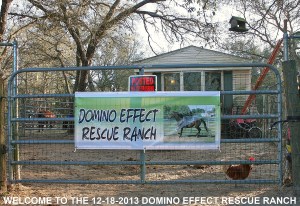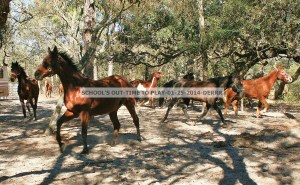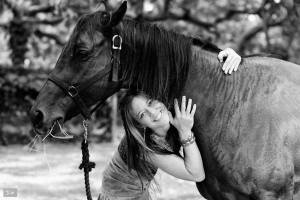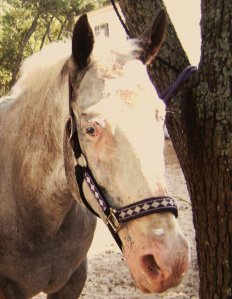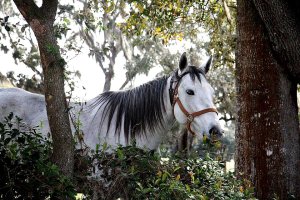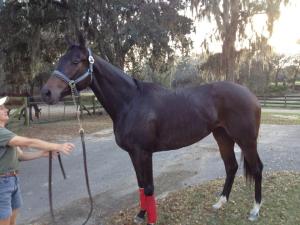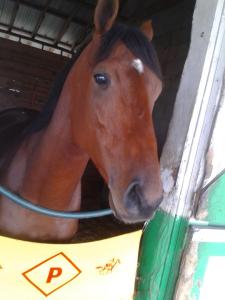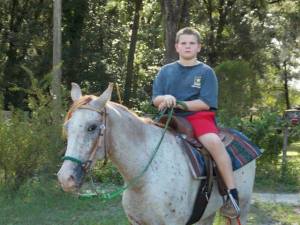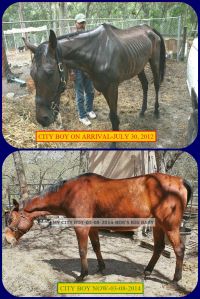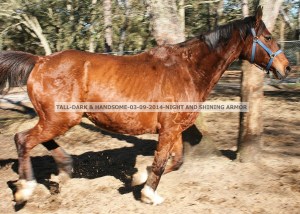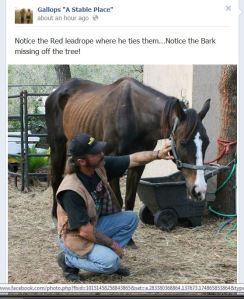Silent Cries
Today’s society struggles with how to manage the unwanted horse. People often breed horses for competitive sports. Horses sustain injuries while performing these sports and often can no longer do as before. Horses become expendable and discarded. Horses sent to auctions, slaughterhouses, rescues, or often euthanized.
My husband and I opened the Domino Effect Rescue Ranch in Weeki Wachee in December 2009, just a few years after the economy declined. Initially, we welcomed wildlife, livestock, and domestic animals. By the summer of 2011, we were busting out at the seams. The phone continued to ring with calls for help. People were in urgent need to find homes for their horses. Horses arrived at the DERR for all different reasons, classifying them as the unwanted horse. At this point, Bob and I dedicated our mission to the equine world where we could better serve our community by saving one horse at a time.
“What classifies the unwanted horse and how do they get into this predicament,” one might ask?
A Hispanic fellow called asking us to take in his colt. He had purchased this Thoroughbred to train and compete at the track. He said that he thought his horse was suffering from EPM, equine protozoal myeloencephalitis. This disease is usually contracted by an infected opossum urinating in the pasture and then ingested by the grazing equine. EPM causes neurological damage that progresses if left untreated. Therefore, the horse becomes ataxic, which leads to the horse becoming a danger to itself and others (Pascoe). He could not afford the medical treatment and advised euthanasia. He called us instead and we came to his rescue. On arrival, the owner attempted to load this colt on the horse trailer. The horse, in fear of the trailer, reared up and went over backwards. He hit his head on the ground and knocked unconscious. Blood was draining out of his ear from the hard blow to his head. “This has happened once before,” the fellow exclaimed. When the colt arrived to the DERR, Bob named him Wild Child. He reflected an unstable gait that resembled EPM. A veterinarian came out to see him and EPM was quickly ruled out. She thought that he might have Wobbler’s Disease. Wobbler’s is a genetic disease that is progressive and compresses the cervical vertebrae together, resulting in death. Without the extensive testing, we were unsure of a definite diagnosis. After a few months Wild Child began to thrive. He was no longer exhibiting any signs of disease and was walking, running, and playing without falling. After sharing Wild Child’s history with another veterinarian, her opinion was that Wild Child had possibly damaged his inner ear when he reared up, went over backwards, and hit his head. This damage had slowly repaired itself over time, leaving him with a happy and healthy life in front of him.
Katie was an absolutely beautiful Appaloosa with just one eye. She had an empty socket where the other eye was. Katie had an eye infection left untreated resulting in her having the eye removed. She would startle easy if approached too quickly on that side. Katie became less desirable with her one eye and stood out in the crowd. She’s discarded from her family and sent to the DERR. After a few short months a young woman called us about Katie. She had seen her advertised for adoption and recognized her. She told us that Katie was her sister’s first horse when she was little. Jessica and Katie reunite after more than a decade of being apart. Katie is now a kid’s lesson horse. She’s loved unconditionally by innocent eyes that see her true beauty within.
Silver Miss was a beautiful, gray Thoroughbred. She had just turned six and was now too old to race. She ran her last race on Thursday and by the following Monday she arrived at our front gates. She could no longer be of service to her owners, so it was time for her to move on.
Nick Rules and Lady are Thoroughbreds owned by the same owner, but resided at different racetracks in Florida. They had both suffered similar injuries resulting in a floating bone chip. They required ninety days of stall rest to rehabilitate. Their owner was not willing to cover the cost for these two Thoroughbreds to stand in the stall for three months and heal. Therefore, he scheduled to have these two horses euthanized. We received a phone call from a vet tech asking if we would rescue these horses from their death sentence and we did. After a substantial amount of time to rest and heal, these two beautiful Thoroughbreds had a full recovery and adopted into new homes.
Indy was a 5-year-old red roan Appaloosa gelding that arrived to the DERR with his buddy Ace. He had a grapefruit-size mass behind his right rear hind foot. The veterinarian came out to treat Indy. In fear that this might be a parasitic cause of Pythium, he did an emergency resection to remove the mass away from the bone. After a series of surgical procedures and multiple leg wraps, Indy made a full recovery. He was perfectly matched with a 9-year-old boy who became his new best friend.
City Boy had previously been adopted to a gentleman who boarded his horse on another woman’s property in Tampa. The horses there were standing knee-deep in mud. He was a truck driver and spent most of his days and nights on the road. The woman was given money for feed, but instead spent it on drugs. In passing, he would blindly see his friend slowly withering away. City Boy stomped his feet impatiently day after day waiting to eat. He lost over 700 pounds in 2-months’ time and covered with severe rain rot. As death was nearing, a trailer pulled up and opened its doors. His rescuer had come for him. He leaped into the trailer, as if he was leaping into the arms of love. A few months of tender loving care and 800 pounds later, City Boy was a stunting, muscular horse who was now full of life. City Boy still resides here at the DERR with us as one of our personal horses. He has become a part of our family and will always have a home.
Mikey arrived to the rescue in the fall of 2013. His condition is DSLD, degenerative suspensory ligament desmitis. This is a disease that might be hereditary, but more likely caused by overuse and the breakdown of the suspensory ligaments. Mikey is a 17-year-old Oldenburg who came to the United States from Germany. Mikey competed as a hunter jumper. Horses who compete repetitively in these sports acquire a breakdown of the tendons and ligaments after strenuous activities without receiving the proper medical care and rest. As the suspensory ligaments breakdown, the pasterns drop and become horizontal instead of standing upright at a slight degree. This conformational defect causes severe pain to the horse, as the horse’s weight bears down on this horizontal plane (Halper). The first few months that Mikey was with us he spent hours lying on the ground in pain. We medically treated him with daily doses of phenylbutazone to manage his pain level. It was time to euthanize Mikey and put him out of his suffering. Over the next few weeks as we were gathering the funds to have him euthanized, Mikey began to improve. The veterinarian came out to see him and noticed that he was gaining strength in his pasterns and was standing more upright. When Mikey arrived, he was 16.1hh. Today he is measuring 17hh. He runs and plays with the other horses with no more limping, lying around, or pain. He is a gentle giant with the most lovable disposition you could ask for in a horse. His radiant glow beams with appreciation for life.
Justice came into the rescue after a 911 call. Justice, aka Bella Capote, was a famous Thoroughbred racehorse. After his racing career was over, he passed through many hands. He arrived at a rescue in South Florida where he stayed for 2 years until it closed. The horses suffered from neglect and starvation over a long period. While these horses searched for food, they ate poisonous plants called crotalaria. These plants were toxic to their systems and poisoned their liver. Unfortunately, the liver must sustain 70% damage before any symptoms are visible. Once there are symptoms of liver damage, the liver has already progressed to liver failure and most times is irreversible. We responded to a 911 call to pick up Justice. At the time that we picked Justice up, I do not think a preceding diagnosis existed. The first day he had an excessive amount of diarrhea and did not want to eat his grain. After closer inspection, he was found to have ulcers in the top of his mouth and under his lips. The next two days his anus began to bulge and ruptured with blood flowing down his legs. After one week he was showing signs of depression, lethargy, head pressing, circling, aimless walking, dysphagia, ataxia, dysmetria, persistent yawning, pica, increased friendliness, aggressiveness, and stupor (Stegelmeier). On the tenth day, his temperament became violent. He was falling into everything around him. His legs would literally fall out from underneath him, leaving him to fall violently to the ground. He had become a danger to us and to himself. The veterinarian arrived the next morning to have him euthanized. His blood tests came back showing positive for severe liver failure and hepatic encephalopathy.
We raise horses from babies to respect and please their owners. They learn to trust us and are completely dependent on us for their care. Horses train for competitive sports, recreational use, and as companions.
Horses are not born unwanted, but become expendable due to life-changing circumstances. When horses can no longer meet their owner’s expectations, they are rehomed or euthanized. Most commonly, horses find themselves homeless after their owners become unemployed, move, old age, or acquire debilitating health conditions. Many times people find themselves a dollar short and cut out the necessities like buying grain and feed for their horses. Over time these horses begin to lose weight and the owners become ashamed. They hope that they can change the situation around quickly and become too embarrassed to call for help. During this time these horses pray that someone will see them, save them, or hear them cry. They stand for days, stomping impatiently, hoping that anyone will notice them. Soon they are too weak to stomp and can no longer get off the ground. Time is running out, soon it will be too late. Give me a voice Dear Lord, so that I may call for help, so that someone might hear my silent cry.
